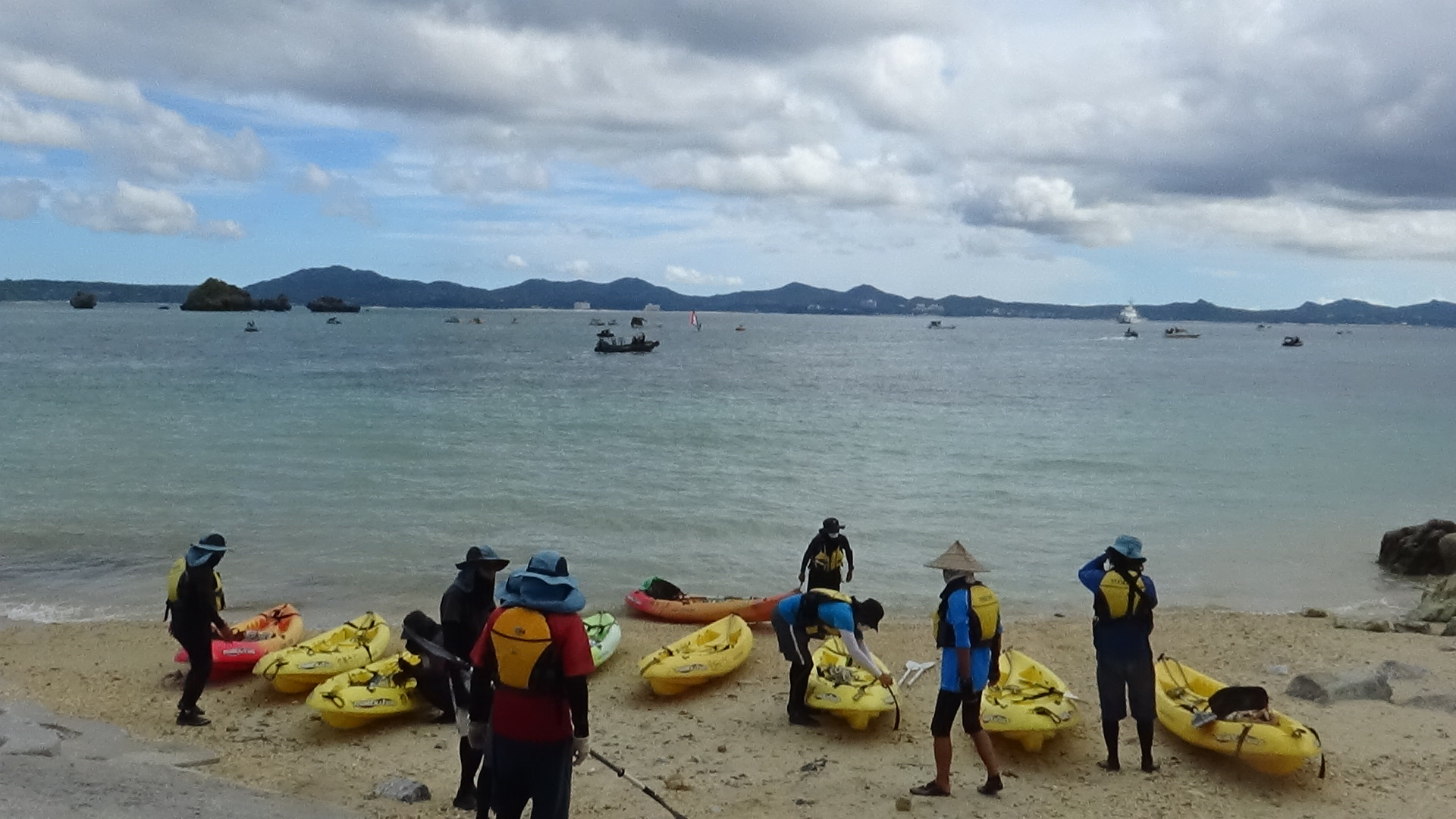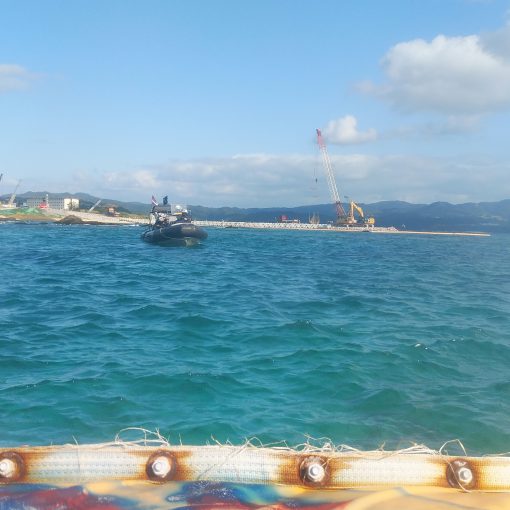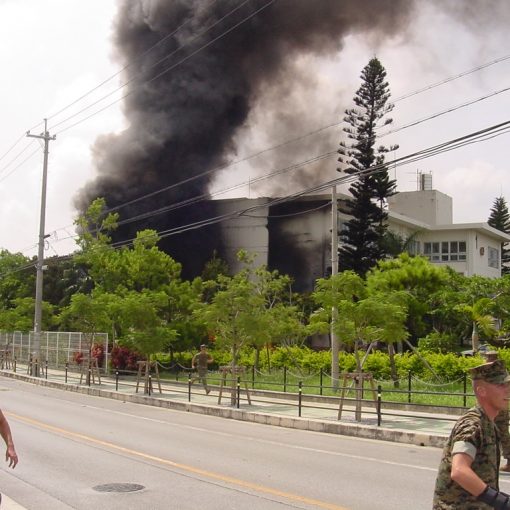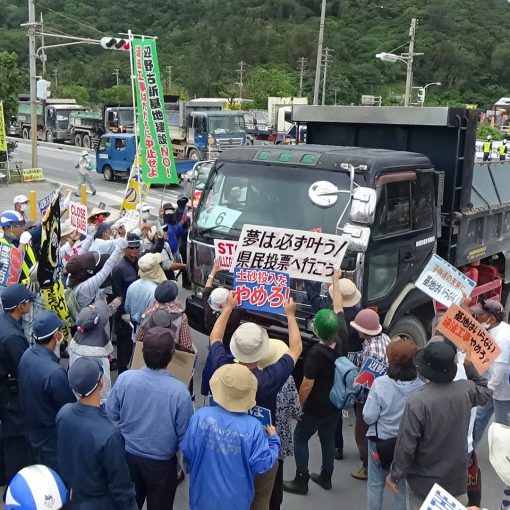The tent in front of Camp Shwab, which welcomes the protesters, measures 80m in length. Takemasa Kinjo(63) built a large part of the tent. He is dexterous, having worked in designing and phototypesetting for many years in Tokyo. The signboards and plasters that he has made for the protest movement amounted to over one hundred pieces.
Takemasa was born and raised in Henoko, the town of Camp Schwab. Most of the town residents were against the new base in Henoko when the central government first brought up the plan. However, due to the government’s long-standing appeasing and dividing measures, only a few people now speak out and oppose it. “Everyone is against it in their hearts, but it’s difficult to voice it in front of the village head who has agreed to build the base here. Some people even believe that each household will get 100 million yen from the government.”
Generations are gone. Nowadays, Pro-base residents alienate Takemasa and harass him. Junior-high students call him rudely, “Hey, Kinjo!” “It makes me sad. Pro-base parents made these kinds call me such way,” says Takemasa.
Recently, his friends repeatedly suggest to him, “Takemasa, you should talk about what happened to your mother.” Indeed, younger ones in the village do not know about the tragedy of the Kinjo family.
The accident occurred when Takemasa was 17 years old. His mother, Tomiko, used to run a bar. On that day, she was in the bar, preparing to open the bar. An American soldier came in and murdered her by hitting with a cement block. The murderer stole $10 from the bar. His father was teaching Sanshin on the 2nd floor at that time but heard nothing. Takemasa ran to the hospital from the school but was not allowed to meet his mother in a horrible disfigure.
The murderer was caught in the next town. But the U.S. military tried and released him soon, and he returned to the U.S. Under the Japan-U.S. Status of Forces Agreement, the U.S. military men are protected, and Japanese police could not investigate the U.S. military personnel matters. It’s still almost the same now.
Takemasa is keenly aware that this is what it means to have a military base in the village, having experienced his mother’s unfortunate murder. Recently, he thinks that he should tell people about the ramification that military bases bring about, including his mother’s case.

(In front of the Camp Shwab Gate)
At 8:40 in the morning, about 30 people sat in front of the Gate after repeating many slogans. Hearing the news that Suga was elected for the Prime Minister’s Office of Japan, the protest-participants said, “It’s just a continuation of the Abe administration. We can’t expect anything positive.” “He is the man who put Okinawan people under his mercy using money to divide Okinawan. Severe criticism continued, such as “He may be more ruthless to Okinawa than Abe in dealing with U.S. Military problems. Even though the administration changes, the protest scene will not change as long as the new base construction continues. The protestors hauled strong and loud voices at the lined-up trucks.
(Ryukyu Cement Awa Pier)
Approximately 20 people, including Shima-Gurumi Uruma chapter members, continued to protest at the pier’s entrance and exit in the light rain. Five GoGo drive members also participated. Nine canoe team members tied the canoes to the net under the pier to block the departure of carrier ships. All teams ended up detained and taken back to the beach, but they succeeded in delaying the ships’ departure to Henoko for nearly an hour and a half.
Work stopped for almost an hour due to a conveyor belt failure. But, a total of 773 truckloads of the earth and sand was loaded onto three ships.



(Motobu Shiokawa Pier)
There were only four protesters from the Shima-Gurumi Motobu chapter. There is no police figure. In the heat and dust blown by the dump trucks, they continued to protest by walking in front of the dump trucks holding a banner all day long.

Number of dump trucks to date and percentage against the total
The estimation calculated on the basis of the number of ruckloads serves only as a reference.
Number of dump trucks which made delivery from December 2018 to the end of December 2019 114,601(1.39%)
| 12(Sat) | 14(Mon) | 15(Tue) | 16(Wed) | 17(Thr) | 18(Fri) | |
| Awa | 665 | 592 | 530 | 773 | ||
| Shiokawa | 0 | 510 | 512 | 511 |
| Number of dump trucks ※ |
Weightt of earth/sand
※① |
Converted to volume
※② |
Volume per Total
※③ |
| 241,437 | 1,207,185t | 603,593㎥ | 2.988% |





